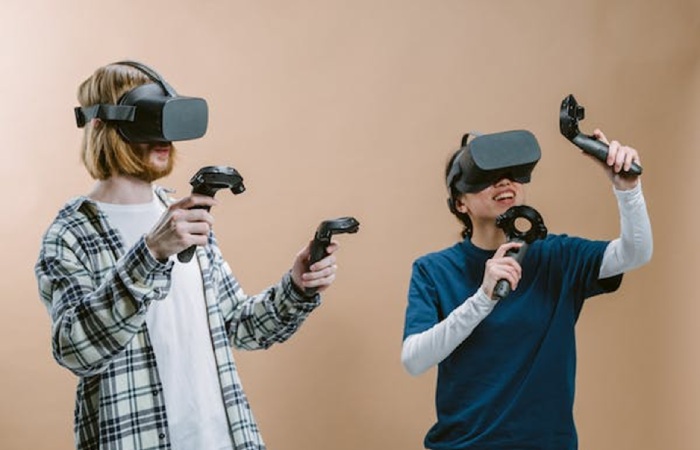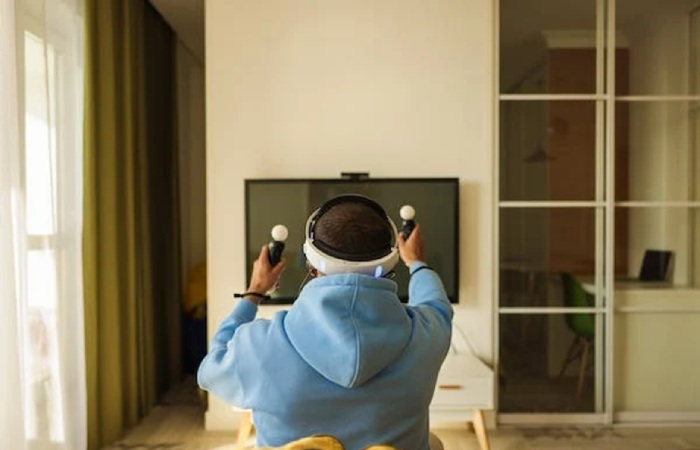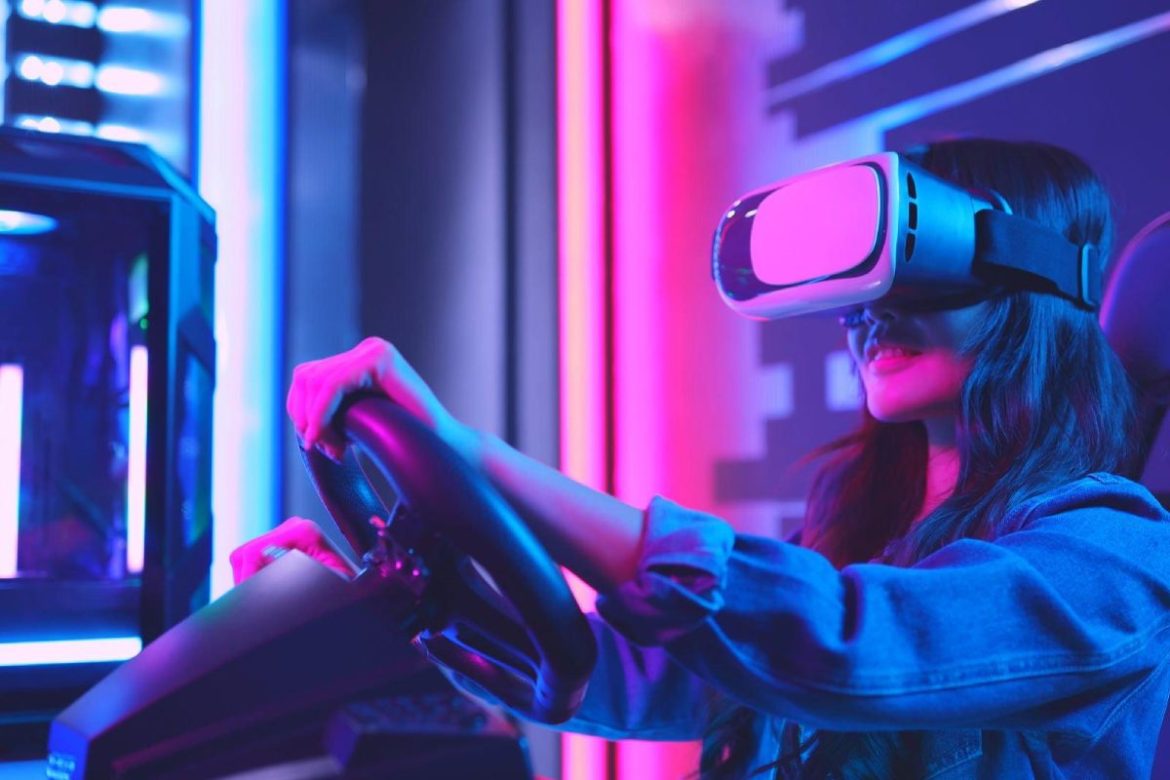The dawn of virtual reality has revolutionized the gaming industry. From the immersive experiences that it offers to the heightened levels of engagement and satisfaction, VR has completely changed how we consume entertainment.
Gone are the days when gamers had to settle for two-dimensional titles with limited graphics; now they have access to fully immersive three-dimensional environments.
Through the use of headsets and motion controls, players can become part of the game world instead of just controlling characters within it. The effects of this change are already being felt throughout the gaming community as more people discover what VR games have to offer.
Not only does VR provide a level of immersion unmatched by traditional consoles or PCs but also comes with several benefits over them too; research indicates that playing in virtual reality can improve cognitive abilities such as problem solving and focus while boosting creativity and imagination.
With these advantages combined with alluring visuals, incredible sound design and intuitive control schemes, there is no doubt about why so many people are ditching their old systems for a taste of next-gen gaming in VR!

Table of Contents
Hardware And Software Requirements
Having defined what virtual reality gaming is, it’s now time to explore the hardware and software requirements that make this type of gaming possible. That said, there are a few misconceptions about these requirements which need to be addressed.
Many people believe that the equipment needed for VR gaming must be expensive in order to offer an immersive experience. This simply isn’t true – while some high-end headsets may come with hefty price tags, you can get just as good an experience from mid-range devices if they’re paired with quality content.
When it comes to required hardware, most VR games require gamers to use either PC or console powered headsets along with motion controllers such as joysticks or gamepads.
The majority of popular titles also demand at least 8GB RAM and a graphics card capable of running DirectX 11 or higher on a Windows 10 operating system (or equivalent).
Additionally, many newer versions will require users to have access to 4K resolution displays so they can take advantage of all available features.
At its core, virtual reality gaming requires both software and specialized hardware components in order for players to enjoy their experiences fully.
While companies like Oculus and Playstation provide complete packages tailored towards different types of gamers, those who want more control over their setup should look into investing in individual pieces of equipment based upon their budget and desired level of immersion.
Whatever route one takes though, having the proper setup ensures gamers will never miss a beat when playing any title out there!
Immersive Experiences
Immersive experiences in virtual reality gaming are something that many players seek. VR technology offers gamers a way to enter into worlds they could never experience otherwise, and it can be an incredibly visceral experience.
In fact, some people have reported feeling like they were actually inside the game world while playing games with immersive VR technology. This sense of being present within the environment is what makes virtual reality such a powerful tool for gamers.
One benefit of this level of immersion is that it allows gamers to truly become part of the game world. They don’t just control their character; they can actually inhabit the space around them and interact with objects in meaningful ways.
This adds another layer to gameplay, as users must think about how their actions will affect other characters or elements of the environment around them. It also adds a deeper connection between player and character, which enhances engagement even further.
In addition to deepening engagement, immersive VR gaming can open up new possibilities for creative expression and exploration.
Players may find themselves inspired by the environments they find themselves in, allowing them to come up with ideas that wouldn’t have been possible without fully immersing themselves in the game’s atmosphere.
Furthermore, when combined with haptic feedback devices or advanced motion tracking systems, these types of experiences can make for an incredibly lifelike journey through a virtual world – one that feels almost real enough to touch.
VR gaming has revolutionized how we play video games and opened up entirely new avenues of entertainment and exploration.
With its ability to create highly immersive experiences, there’s no denying that this emerging technology is here to stay – and there are sure to be more exciting developments on the horizon!
Health Risks And Precautions
Moving on from the immersive experience of virtual reality gaming, it’s important to discuss potential health risks and precautions that should be taken when engaging in this activity.
VR gaming has been found to have both physical and psychological impacts, so gamers must take care not to overdo it or become too involved in the game.
Here are a few key points to consider:
- Physical Health Risks: Prolonged use of VR headsets can cause eye strain, neck discomfort and other physical discomforts due to its weight or design. It is also recommended that players take regular breaks during their sessions as they may feel dizzy after extended periods of playtime. Player should use quality headset. They can buy headset after reading reviews; for instance, digital monster Vr review.
- Psychological Effects: Studies have shown that playing games in virtual reality can create feelings of anxiety, fear, apprehension and even nausea in some cases. Gamers should keep an eye out for these signs and adjust accordingly if needed by limiting their time spent with the headset on or taking a break altogether.
- Safety Measures: To ensure safety while using a VR headset, make sure you have adequate space around you away from any furniture or objects that could be hazardous if bumped into during game play. Also check your cables are secured properly and secure any loose wires before starting your session to avoid tripping hazards.
Given all this information about the potential effects of virtual reality gaming, it is essential for gamers to exercise caution and practice responsible gaming habits whenever engaging in this activity; otherwise they risk suffering long-term physical or psychological damage due to overexposure or incorrect usage of the equipment.
Taking proper safety measures will go a long way towards ensuring enjoyable experiences without any unwanted side effects!
Educational Opportunities
The possibilities of virtual reality gaming in the educational landscape are mind-boggling. Like a blank canvas before an artist, VR presents educators with a wealth of new tools to engage students and enrich their learning experience.
With its immersive environment and seemingly endless range of applications, it’s no wonder why so many schools have already begun to explore Vr as an instructional aid.
One key area where VR is having a profound impact on education is by providing teachers with more interactive ways of presenting material than ever before. Through this medium, lessons can become exciting, engaging experiences – not just for those who learn best through visual stimulation, but also for all types of learners.

As if opening up a portal into another world, Virtual Reality allows students to see subjects from fresh perspectives and gain valuable insights that wouldn’t otherwise be available in traditional classrooms.
By bringing together aspects from different disciplines such as art or history, teachers can create customised lessons tailored precisely to each student’s needs and interests.
At the same time, Virtual Reality provides several opportunities for assessment that weren’t possible until now: evaluations which are more accurate and reliable because they measure performance within real-life scenarios rather than simulated ones. This means instructors will be able to assess how well students understand subject matter more accurately and identify areas needing further attention swiftly – something especially useful when dealing with large classes or multiple topics at once.
VR gaming truly has unlocked doors that were previously shut tight when it comes to education; allowing educators to take advantage of modern technology while still ensuring that learning outcomes remain meaningful and substantial. The future looks bright indeed!
Conclusion
It’s clear that virtual reality gaming has the potential to revolutionize the way we interact with technology. From an immersive experience that puts you in a believable world, to educational opportunities and health risks and precautions, VR is making its mark on the gaming industry.
With more developers getting involved and new hardware continually being released, it’s no wonder why this form of entertainment is so popular.
However, even though there are many benefits associated with VR gaming, gamers need to be aware of the possible health risks they may encounter while playing these games. If users don’t take proper safety measures or aren’t using quality equipment, they run the risk of suffering from motion sickness or other physical issues related to prolonged exposure.
Additionally, those who play for extended periods could experience negative mental effects such as anxiety or depression due to overexposure.


